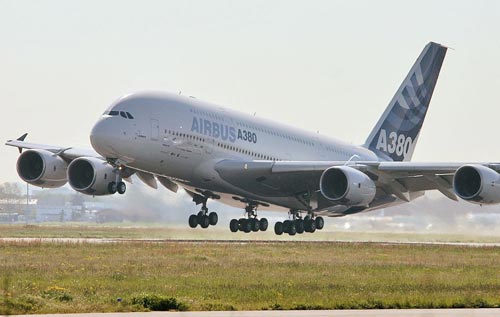The A380's upper deck extends along the entire length of the fuselage, with a width equivalent to a wide-body aircraft. This allows for an A380-800's cabin with 478 square meters (5,145.1 sq ft) of floor space; 49% more floor space than the next-largest airliner, the Boeing 747-400 with 321 square meters (3,455.2 sq ft), and provides seating for 525 people in a typical three-class configuration or up to 853 people in all-economy class configurations. The A380-800 has a design range of 15,400 kilometers (8,300 nmi; 9,600 mi), sufficient to fly from New York to Hong Kong, and a cruising speed of Mach 0.85 (about 900 km/h or 560 mph at cruising altitude).
As of February 2012 there had been 253 firm orders for the A380, of which 72 have been delivered. The largest order, for 90 aircraft, was from Emirates.
Production:
Major structural sections of the A380 are built in France, Germany, Spain, and the United Kingdom. Due to their size, they are brought to the assembly hall (the Jean-Luc Lagardère Plant) in Toulouse in France by surface transportation, though some parts are moved by the A300-600ST Beluga aircraft used in the construction of other Airbus models. A380 components are provided by suppliers from around the world; the five largest contributors, by value, are Rolls-Royce, Safran, United Technologies, General Electric and Goodrich.
The wings are manufactured at Filton in Bristol and Broughton in North Wales, then transported by barge to Mostyn docks, where the ship adds them to its cargo. In Saint-Nazaire in western France, the ship trades the fuselage sections from Hamburg for larger, assembled sections, some of which include the nose. The ship unloads in Bordeaux. The ship then picks up the belly and tail sections from Construcciones Aeronáuticas SA in Cádiz in southern Spain, and delivers them to Bordeaux. From there, the A380 parts are transported by barge to Langon, and by oversize road convoys to the assembly hall in Toulouse.
After assembly, the aircraft are flown to Hamburg Finkenwerder Airport (XFW) to be furnished and painted. It takes 3,600 L (950 US gal) of paint to cover the 3,100 m2 (33,000 sq ft) exterior of an A380. Airbus sized the production facilities and supply chain for a production rate of four A380s per month.










No comments:
Post a Comment